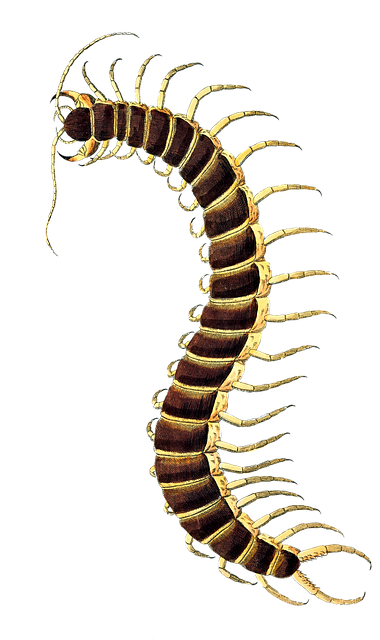Centipede infestations can be managed by understanding their behaviors and types, which prefer dark, moist crevices. Common species include house centipedes and Asian giant centipedes. Eco-friendly solutions like diatomaceous earth, neem oil, and boric acid disrupt exoskeletons or dehydrate centipedes, making them safer alternatives to pesticides. Prevent infestations through proper landscaping, sealing cracks, and cleaning moisture areas. Natural repellents include essential oils, and boric acid powder can be used with caution. For severe cases, professional eco-friendly treatments combine targeted pesticides, sealing entry points, sanitation, and regular inspections for lasting solutions without harmful chemicals.
Centipedes, though beneficial in controlling other pests, can become a nuisance when they invade your home. This article provides an effective guide to eliminating centipede infestations with a focus on eco-friendly solutions. From understanding common types and their behaviors to natural repulsants, home remedies, and professional treatment options, you’ll discover safe and sustainable ways to reclaim your space from these creatures. Explore these strategies for an infestation-free environment while preserving the balance of nature.
Understanding Centipede Infestations: Common Types and Behaviors
Centipede infestations can be a nuisance, but understanding their behaviors and types is crucial for effective management. Centipedes are largely nocturnal, preferring dark, moist crevices like cracks in walls, beneath floors, or within closets. They are attracted to moisture and often enter homes during humid periods or after rainfall. There are several common types, including the house centipede (Nauphoeta cineraria) and the Asian giant centipede (Meristopon melanocomum), each with distinct characteristics. The house centipede is known for its preference for warm environments and its tendency to travel along walls, while the Asian giant centipede is larger and more aggressive, often seeking out human contact due to their curiosity.
Identifying eco-friendly centipede solutions is essential for those who prefer non-toxic methods. Organic options like diatomaceous earth, neem oil, or boric acid can be effective deterrents. Diatomaceous earth, made from fossilized algae, disrupts the centipedes’ exoskeletons, while neem oil acts as a natural insecticide. Boric acid, when applied cautiously, can also eliminate centipedes by dehydrating them. These eco-friendly solutions not only help control infestations but are safer for pets and children compared to traditional pesticides.
Eco-Friendly Prevention Strategies to Avoid Centipede Intrusions
To prevent centipede infestations, consider implementing eco-friendly strategies that promote a healthy and balanced environment. One effective approach is to maintain proper landscaping by keeping grass mowed and shrubbery trimmed, as centipedes are attracted to long grass and dense vegetation. Additionally, eliminating potential hiding spots around the exterior of your home, such as piles of wood or debris, can significantly reduce their access points.
Sealing cracks and gaps in walls, foundations, and doors is another crucial step. These entry points allow centipedes to sneak into your home unnoticed. Using eco-friendly sealing products, like silicone caulk, ensures that you mitigate the risk without introducing harmful chemicals. Regular cleaning and sanitizing of areas prone to moisture buildup also deter centipedes, as they are drawn to humid environments.
Natural Repellents and Home Remedies for Centipede Control
Many homeowners prefer natural, eco-friendly centipede solutions due to their safety and minimal environmental impact. Essential oils like lemon eucalyptus, peppermint, and citronella are effective repellents, known for their strong scents that centipedes dislike. Mixing these oils with water and applying them around entry points, such as doors and windows, can create a barrier against these pests.
Another popular home remedy involves using boric acid powder. This natural substance can be sprinkled in areas where centipedes are commonly found. Boric acid is toxic to centipedes when ingested, making it an effective control measure. However, it’s crucial to keep this powdery substance out of reach of children and pets for safety reasons.
Professional Treatment Options: Safe and Effective Solutions
When it comes to severe or persistent centipede infestations, professional treatment options offer safe and effective solutions. Many pest control services now provide eco-friendly centipede solutions that minimize the use of harsh chemicals, ensuring a healthier environment for both you and your family. These methods often involve advanced techniques such as targeted applications of natural pesticides, which are designed to eliminate centipedes without damaging non-target organisms or contaminating the soil and water.
Professionals also employ strategies like sealing entry points, removing moisture sources, and using sticky traps to monitor and control centipede populations. By combining these eco-friendly centipede solutions with preventive measures, such as regular inspections and proper sanitation, you can achieve a lasting solution to your centipede problem, enjoying a pest-free home without resorting to potentially harmful chemicals.
In tackling centipede infestations, a multi-faceted approach combining understanding, prevention, and effective treatments is key. By adopting eco-friendly strategies and exploring both natural remedies and professional solutions, homeowners can reclaim their spaces from these pesky critters. Remember, with the right knowledge and tools, eliminating centipedes doesn’t have to be an unpleasant or harmful process—it can be a simple, sustainable step towards a pest-free home.
